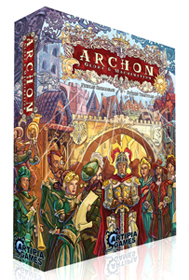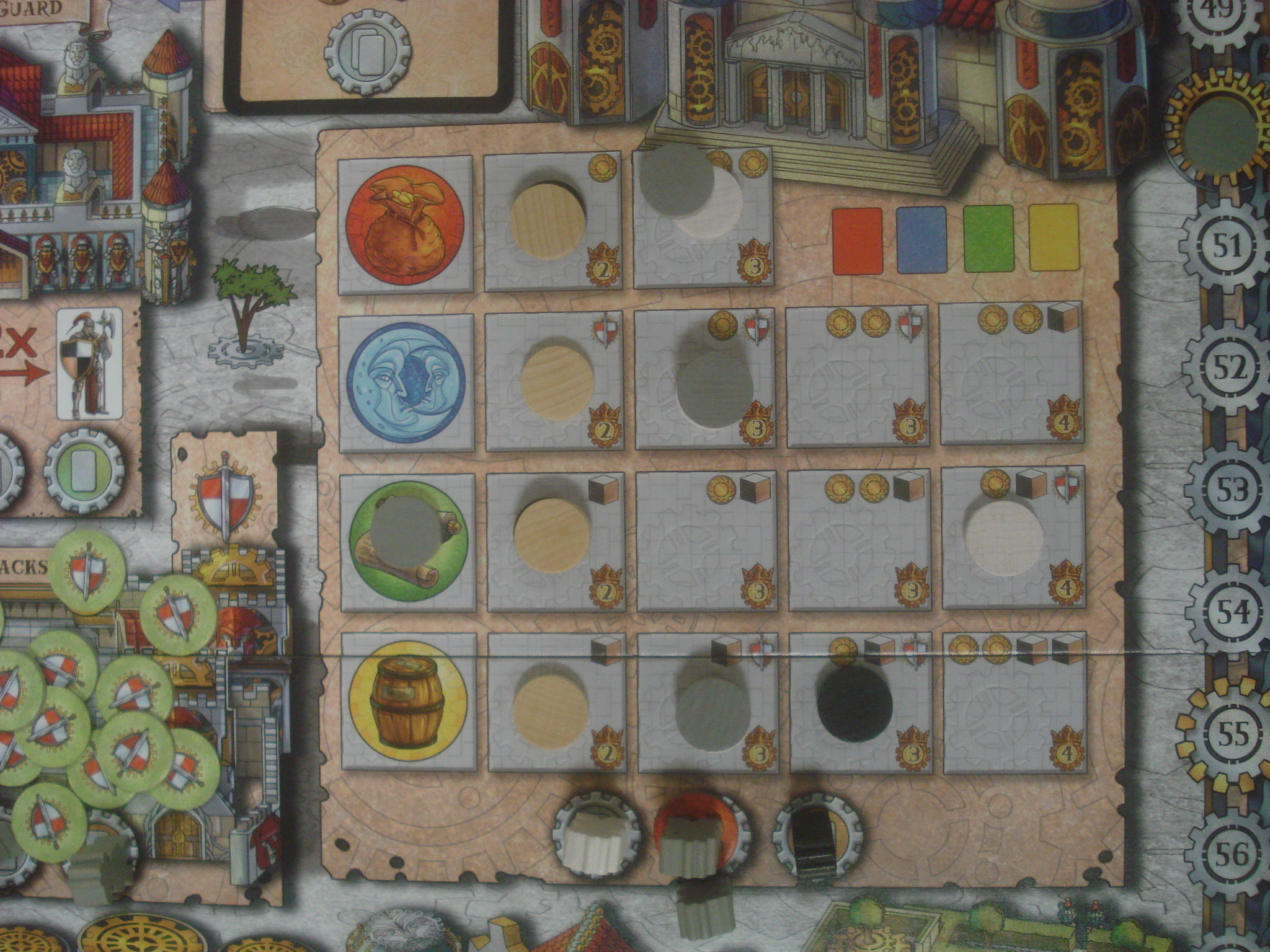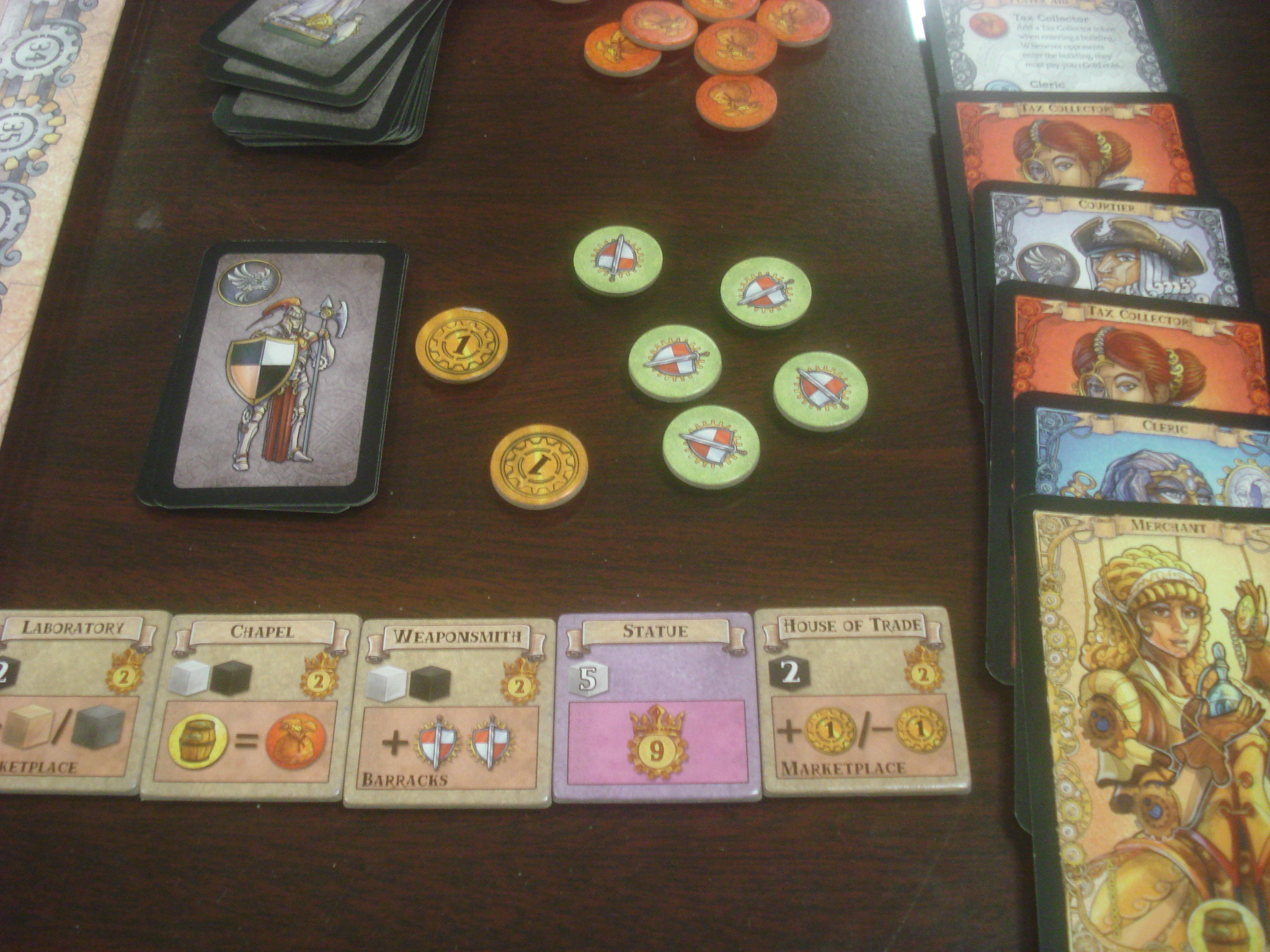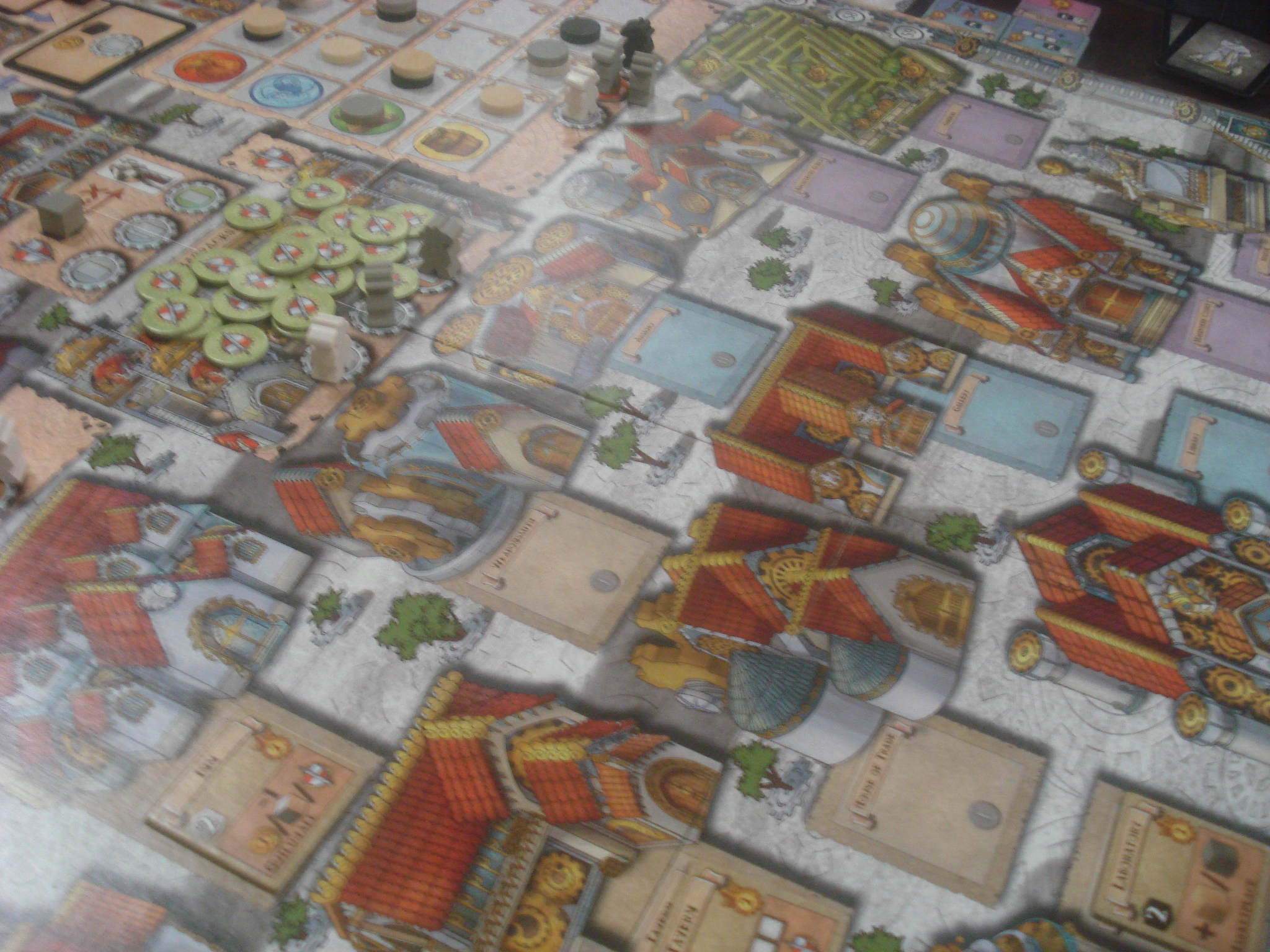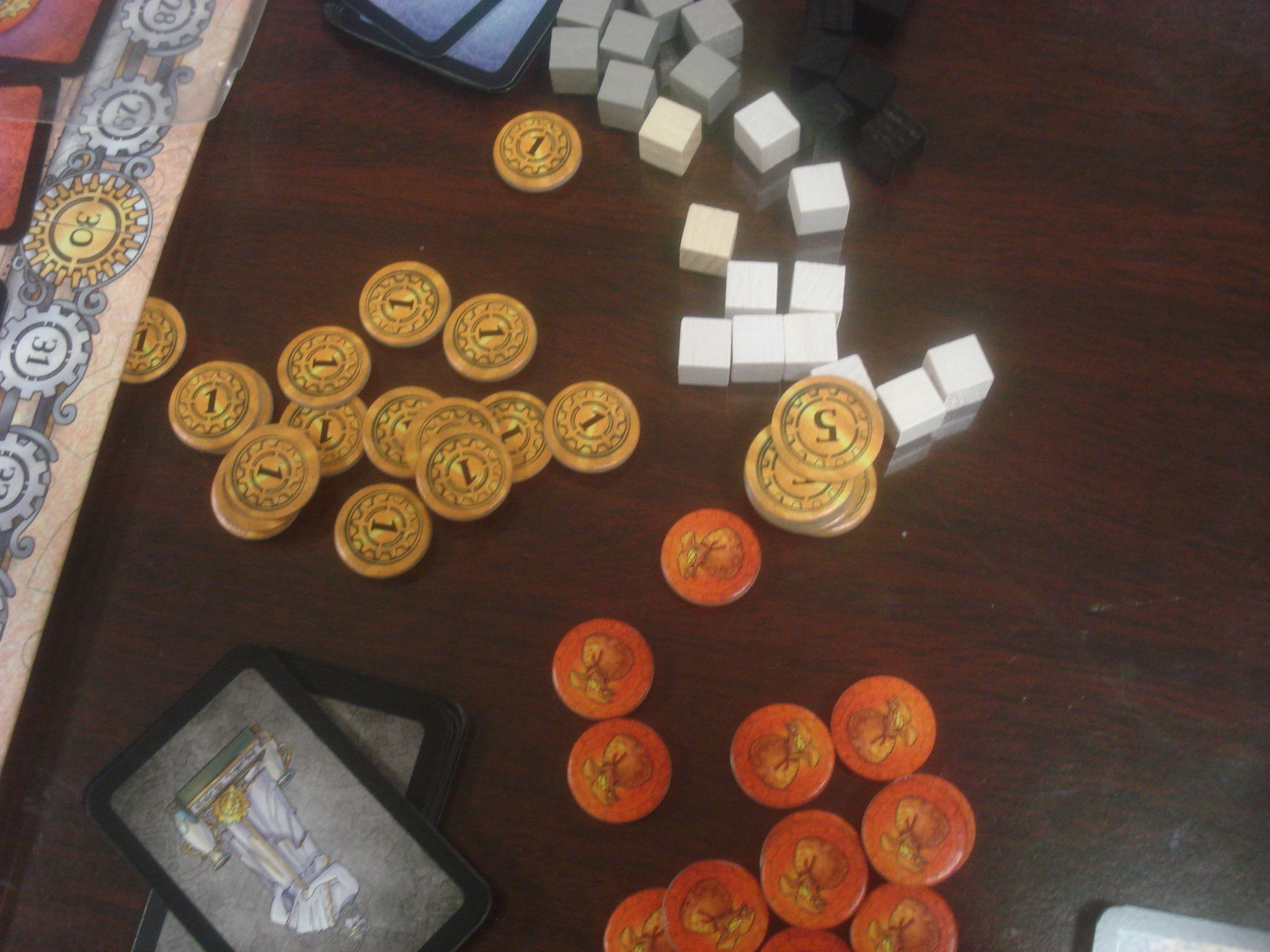| Publisher | Artipia Games |
| Design Credits | Nikolas Sakaloglou, Sotiris Tsantilas, Pantelis Bouboulis, Kostas Retalis, Konstantinos Kokkinis |
| Art Credits | Antonis Papantoniou, Giota Vorgia |
| Game Contents | Game board, 56 Magister cards, 32 Courtier cards, 20 wooden figures in four colors, 24 wooden discs in four colors, 60 wooden resource cubes. Six King’s Grant cards, 22 King’s Favor cards, 20 one-gold coins, seven five-gold coins, six Attack cards, 16 Tax Collector tokens, 25 Recruit tokens, 23 Building tiles, one Season Track token, four 60-Victory-Point tiles, nine Action Cover tokens, 23 Science cards, 23 Arts cards, 20 Elite Warrior cards, 20 Province cards, 12 Player Aid cards, three rulebooks |
| Guidelines | Power-behind-the-throne kingdom management game |
| MSRP | $65.99 |
| Reviewer | Andy Vetromile |
Can’t royalty do anything for themselves, or do they just enjoy ordering the rest of us about? The king of Cardis is no different: He has a group of Archons who see to most of the running of his kingdom (or his capital city – Cardis seems to refer to both). If this sounds like your kind of job, there’s an opening in Archon: Glory & Machination. Apply within.
The object is to score the most points by the end of three seasons.
Two to four players are Archons, advisors to the King, and they attempt to assist him with the problems arising from operating a sovereign state. Everyone controls a deck of courtiers and a set of Wooden Figurines (yes, that’s what they’re called and how they’re capitalized). Putting one of these workers at a location activates it, but there’s a cost in Courtier cards – better locations, or those already mostly occupied by opponents, require two cards instead of one. The game has three supplies, Recruits, Gold, and Resources (did it go unremarked there’s a lot of capitalization?), and most locations use these in some combination. For example, the Guild Hall hires out various Magisters, demanding a Resource for your first Scribe, a Gold and a Resource for the second, a Recruit for your first Cleric, and so on.
Everyone starts with a hand of ten cards, but through the drafting mechanic one replaces plain-vanilla Courtiers with powerful Magisters: Scribes act twice, Clerics ignore occupancy limitations, Merchants earn extra materials, and Tax Collectors take money from other players. Magisters also fulfill any two-card requirements all by themselves. Players use five cards each round, splitting their 10 Courtiers into two hands – if they’ve replaced Courtiers with Magisters they must plan, or just flat-out guess, which Magisters would best serve which round.
Over the course of three seasons (divided into nine rounds), the King focuses on three priorities, Arts, Sciences, and the military. He rewards achievements in all these endeavors, but the highest bonuses change each season. The King’s Grant may value advancements in the Arts early in the game but put scientific progress at the forefront later on. Whoever offers the most growth – which is to say, collects the most cards in a given arena – gets the best return on his efforts. The military’s secondary purpose is training Recruits to be Elite Warriors: Those cards are stationed along the city wall for defense. At the end of every season, barbarians attempt to invade the capital and if they’re met with Elite Warriors equal to the horde’s size everyone is safe; otherwise each Archon loses some supplies. All military, Arts, and Sciences cards are then discarded; getting those points is done from scratch each season. Resource locations are replenished, the King awards points, and everyone gets their markers back.
There are several ways to earn victory points throughout the game: hire Magisters, be the first defender on the wall, avail oneself of the King’s Favor (a conveyor belt of cards with extra spaces to play workers and gain benefits), and restore the city by erecting new Buildings (which give their owners special advantages). When the third season ends any end-of-game points from Buildings are added to the tally, and the Archon with the most points wins.
This . . . is one magnificent-looking game. The artwork throughout Archon: Glory & Machination is a labor of love that shines brightly. It’s powerful praise for the illustrations – from the Courtier cards to the map of Cardis itself – but it’s also one of the game’s biggest downfalls. The color scheme is horribly off in some key areas. On the board, the pictures of the Resource cubes leave the silvers looking like the blacks, and sometimes the tans look like the whites. The cards for the King’s Favor pose similar difficulties. It isn’t a devastating blow that prevents use of the game, but it’s a non-trivial issue that requires double-takes and reassurances too often for comfort (the trouble can be solved by putting a spare cube on the matching map space just to drive the point home). No expense has been spared for the graphic design – the whole thing is like a beautifully intricate medieval Where’s Waldo? panorama – though the too-busy board makes it tough to tell where one thing ends and the next begins. Not much wasted space here. Further, reduction of the Arts, Sciences, and Elite Warrior portraits on the King’s Grant cards makes them look almost the same at their tiny size. The rest of the components are similarly worthy, with thick cardboard and wood in ample supply. The game even includes Action Covers, used to conceal spaces that aren’t used in a two- or three-player game.
Worker placement games (Wooden Figurine placement games?) usually offer a number of ways to gain points and achieve the win, and Archon: Glory & Machination is no different. Ignoring some parts of the action won’t cost you so long as you have a fairly coherent strategy, and in fact adds to some of the suspense if you think, “Ehhh, let the others man the wall against the barbarians and get those points.” But there’s so much to do and so many moving parts to consider, you must take care not to spin your wheels just getting the last white Resource cube you need to buy that Building you’ve set your heart on. Supplies are tight in this game, and it leaves little room on the fly to maneuver, recover, or make mistakes. Interfering with your opponent’s plays mostly entails accidentally getting in the way or taking prime spaces first – work much more actively than that and you become a kingmaker/spectator/loser. Your best bet is to improve your Courtier deck more than he does his.
If the tight quarters still appeals to you, be warned: The box lists 90 to 120 minutes playing time, and it clocks in at closer to four hours if you have a full house and little experience with it thus far. The game has a lot of familiar mechanics, and while it combines them in some nifty ways (like the card-drafting element), it doesn’t reach a whole other level of play through its innovations. It’s a solid set of rules that satisfy the marathon gamer, but for the casual enthusiast Archon: Glory & Machination is more work and longer hours than may be worthwhile. You could always just intern as a Magister.
